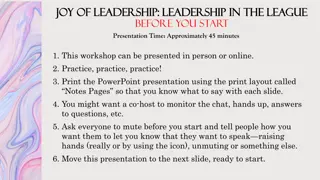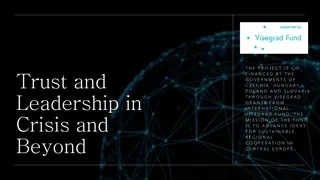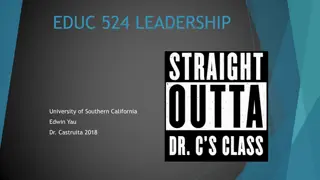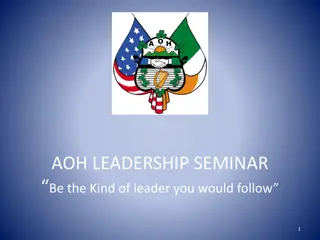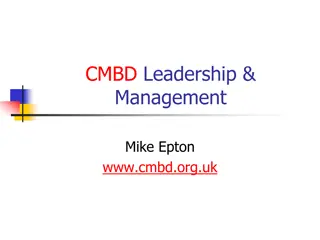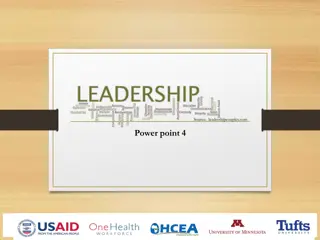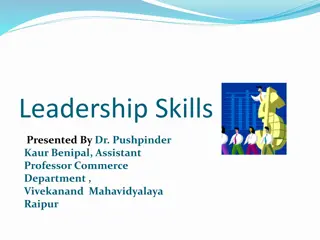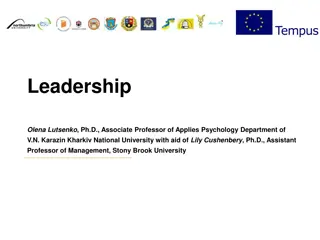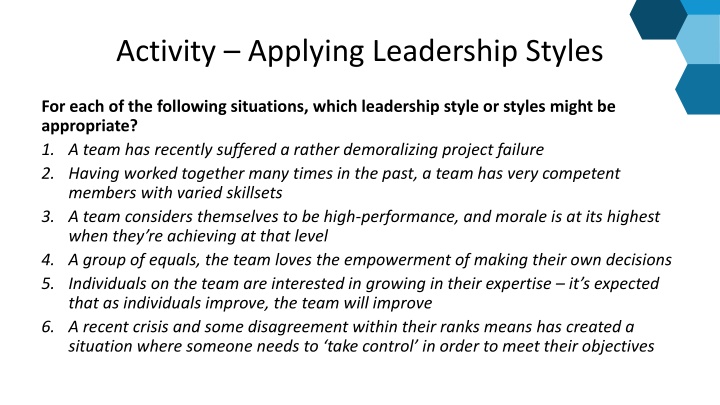
Applying Leadership Styles in Different Team Situations
Explore the appropriate leadership styles for various team situations, such as demoralizing failures, competent team members with varied skills, high-performance teams, empowered decision-making groups, skill development-focused teams, and crisis management scenarios. Understand the importance of adapting leadership styles based on team dynamics and goals.
Download Presentation

Please find below an Image/Link to download the presentation.
The content on the website is provided AS IS for your information and personal use only. It may not be sold, licensed, or shared on other websites without obtaining consent from the author. If you encounter any issues during the download, it is possible that the publisher has removed the file from their server.
You are allowed to download the files provided on this website for personal or commercial use, subject to the condition that they are used lawfully. All files are the property of their respective owners.
The content on the website is provided AS IS for your information and personal use only. It may not be sold, licensed, or shared on other websites without obtaining consent from the author.
E N D
Presentation Transcript
Activity Applying Leadership Styles For each of the following situations, which leadership style or styles might be appropriate? 1. A team has recently suffered a rather demoralizing project failure 2. Having worked together many times in the past, a team has very competent members with varied skillsets 3. A team considers themselves to be high-performance, and morale is at its highest when they re achieving at that level 4. A group of equals, the team loves the empowerment of making their own decisions 5. Individuals on the team are interested in growing in their expertise it s expected that as individuals improve, the team will improve 6. A recent crisis and some disagreement within their ranks means has created a situation where someone needs to take control in order to meet their objectives
Activity Professionalism and Ethics In groups of 3-4, rank the titles on page 2 from most to least ethical Choosing 1 or 2 of your least ethical titles, discuss how an individual with this title may violate each of the 6 professional ethics listed on pages 15-16 Qualification level, protecting proprietary information, dealing directly with conflict, disclosing conflicts of interest, maintaining an attitude of mutual cooperation, advocating for others Choosing 1 or 2 of the most ethical titles, discuss how an individual with this title may embrace each of the 6 ethics Diagram: Malachowsky, Samuel. Project Team Leadership and Communication. Lintwood Press. 2018. p. 2.
Activity Matching Influence to Leadership Leadership Styles Affiliative As individuals or groups, answer the following question: For each leadership style, which types of influence are: 1. Most likely or expected to be used 2. Most likely to be effective 3. Least likely to be effective Authoritarian/Commanding/Autocratic Coaching Democratic Laissez-faire Pacesetting Transformational / Visionary Types of Influence Formal/Legitimate Penalty/Coercive Reward Expert Referent Malachowsky, Samuel. Project Team Leadership and Communication. Lintwood Press. 2018. p. 2-7.
Activity Your Motivators Rank the following motivators from most important to you to least important to you: Autonomy / Interesting Work Interpersonal Relationships Mastery / Exploration Money / Power Purpose Recognition In groups of 3-4 share your most prominent and least prominent motivators. Are there any correlations? Are the majority of your group members intrinsically or extrinsically motivated (see page 8-9)?
Activity Who We Are As Leaders As individuals, take the test in section 1.8, pages 17-19 Score your answers based on the information on pages 19-20 In groups of 3-4, answer the following questions: Which motivators seem most important to people in your profession? Within your group, which type of influence is most prominent? Consider the stakeholder groups on pages 12-13. Which do your group members most identify with? Least identify with? Diagram: Malachowsky, Samuel. Project Team Leadership and Communication. Lintwood Press. 2018. p. 17.

